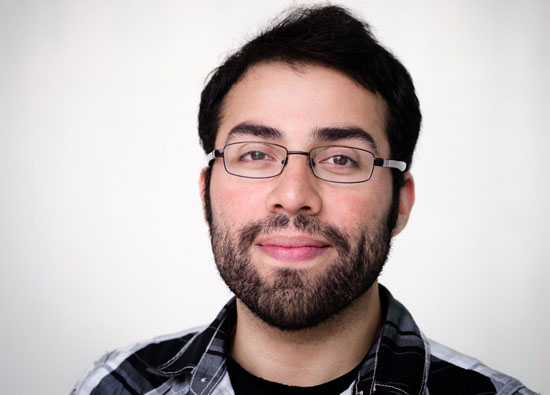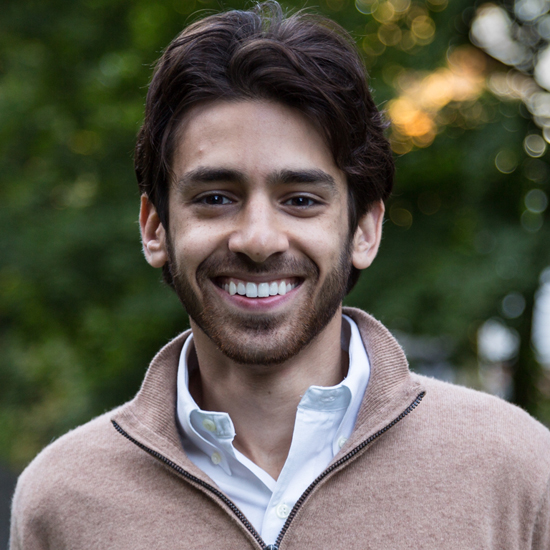Six Alums on Forbes “30 Under 30” List
Young grads bringing change to science, sports, marketing, games

Steve Ramirez’s work erasing and creating memories has been likened to the film Inception. Photo by Joshua Sarañana
Steve Ramirez and Eran Hodis are making an impact in very different areas of science, working in labs only a short walk apart in Cambridge’s Kendall Square. And both Boston University graduates are among six alums who made the Forbes “30 Under 30” list of young “game changers, movers, and makers” in fields such as business, sports, and science.
Ramirez (CAS’10), 27, a neuroscience researcher and PhD candidate at MIT, earned a spot on the list for his work altering the memories of mice, which could have profound implications for humans in areas such as post-traumatic stress disorder (PTSD). Hodis (CAS’07), 29, a cancer researcher and MD/PhD student at Harvard, was named for his work identifying significant genetic mutations in cancer cells, which could lead to better treatments for the disease and eventually unravel its causes.
Hodis works at the Broad Institute of MIT and Harvard, and Ramirez works around the corner at MIT’s Picower Institute for Learning and Memory.
“It’s inspiring to see how these two talented alums have used the excellent undergraduate education they received at BU as springboards for careers that address fundamentally important questions about human life,” says Elizabeth Loizeaux, BU associate provost for undergraduate affairs.
The mouse memory breakthrough by Ramirez and his colleague Xu Liu began with their placing a mouse in a box long enough to form a benign memory of the box and then identifying the brain cells associated with that memory. The following day they put the mouse in a different box and gave it a mild electrical shock—while simultaneously using a laser on those same brain cells to trigger its memory of the first box. On the third day, the mouse was returned to the first box and immediately froze in fear, as if expecting to be shocked. The researchers had implanted in the mouse’s brain a memory of being shocked in a box where there had been no shock.
They began their experiments using a fear response, because it offers the clearest results, but Ramirez says they’ve now moved in a different direction. “We take animals that show certain symptoms that look like depression,” he says, “and we try to reverse those symptoms or alleviate them by artificially reactivating positive memories in their brain.”
And while their work has been likened to science fiction—usually the movie Inception—Ramirez says it has tremendous potential in treating PTSD and other memory-related conditions. Their successes have already brought the team national media recognition, a TED Talk, and now the Forbes “30 Under 30” list.
“The joke I always make is: this is the only way scientists successfully reproduce themselves,” says Ramirez with a grin. “Having things like Forbes as a forum where you can begin to disseminate these ideas that we believe in—because we’re dedicating our lives to them—I think is fantastic. And then hopefully the random high schooler, the random college student who sees this and reads it is like, ‘Oh my god! I didn’t know. The stuff of science fiction is becoming science fact in labs just around the corner in Boston every day.’”
Ramirez says he fully appreciates the value of such inspiration: his parents came here to escape the 1980s civil war in El Salvador.
Paul Lipton (GRS’01), a College of Arts & Sciences professor of neuroscience and director of the undergraduate neuroscience program, points out that Ramirez was in the first cohort of students when the program began in 2008. “Now he is the embodiment of a number of the goals we have for the program,” says Lipton, who is also the Undergraduate Research Opportunities Program (UROP) director. “They are scientific literacy, being a responsible consumer of science, and being able to speak on behalf of science.”
The work that brought Hodis to Forbes’ attention stemmed from the analysis of reams of data that helped identify worrisome mutations in melanoma cells. With colleague Franklin W. Huang, Hodis identified two mutations that could contribute to cells’ runaway growth, and that happen to be among the most common mutations in all of cancer.
“In melanoma, you have one of the highest mutation rates of any cancer,” says Hodis. “You’re looking at hundreds to thousands of mutations in protein-coding genes per sample. The real question is, which of those mutations are crucial to forming the cancer?”
Hodis has since worked on projects identifying mutations in the RNF43 gene that may drive 20 percent of endometrial and colorectal cancers. His work at the Broad Institute explores an existing list of mutations, and he hopes to “understand how they, together in combinations, cooperate to make a melanoma.”
Both scientists credit UROP, which provides financial support for student research under the guidance of a BU faculty mentor, for helping them get started.

“I spent nine-to-five in labs my whole summer,” Ramirez says. “UROP was awesome, because I got to throw myself off the deep end and see whether I enjoy it.”
“That was really my first exposure to research,” says Hodis. “I am really grateful to Professor Joyce Wong for taking me into her lab and starting to introduce me to scientific investigation.”
Hodis was born in Israel and returned there for graduate school at the Weizmann Institute of Science in Eran Segal’s lab, where he learned computational biology and focused on transcriptional regulation in yeast. He returned to the United States in 2010 and changed his research focus after his mother was diagnosed with cancer.
“When his mother died of cancer, that really caused him to shift things,” says Wong, a College of Engineering professor of biomedical engineering. “I could see that changed him a lot and made him focus in terms of wanting to really do something to make a difference.”
Other BU alums named on the Forbes “30 Under 30” list: in the sports category, Michael Kasparian (ENG’12,’14), cofounder of Atlas Wearables, which makes fitness trackers providing 3-D body tracking and advanced data analytics, and Arian Radmand (CAS’08), cofounder of CoachUp, an app connecting athletes to private coaches in their sports; in marketing and advertising, James “Nooka” Jones (COM’10), marketing manager for Google Creative Lab; and in games, Dave Bisceglia (SMG’09), cofounder of Tap Lab, which makes location-aware mobile games such as Bigfoot Hunter.
Among famous under-30 names in various categories are actress Blake Lively, NBA all-star James Harden, and the band Florida Georgia Line, aka Tyler Hubbard and Brian Kelley. Each list was judged by a trio of prominent people in the field. The science judges were MIT mathematician Max Tegmark, Bahija Jallal, executive vice president of MedImmune, and UC Berkeley cell biologist Jennifer Doudna.
Comments & Discussion
Boston University moderates comments to facilitate an informed, substantive, civil conversation. Abusive, profane, self-promotional, misleading, incoherent or off-topic comments will be rejected. Moderators are staffed during regular business hours (EST) and can only accept comments written in English. Statistics or facts must include a citation or a link to the citation.